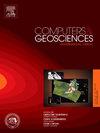Tar yield prediction of tar-rich coal based on geophysical logging data: Comparison between semi-supervised and supervised learning
IF 4.2
2区 地球科学
Q1 COMPUTER SCIENCE, INTERDISCIPLINARY APPLICATIONS
引用次数: 0
Abstract
Accurate and economical prediction of tar yield is essential for precise evaluation of tar-rich coal geological distribution. Through the correlation analysis of conventional logging parameters and tar yield, this identified the highly correlated logging parameters including high-definition deep investigate resistivity log (HLLD), density (DEN), caliper (CAL), acoustic (AC), natural gamma ray (GR), and spontaneous potential (SP). Based on them, the predictive models for tar yield have been built by semi-supervised learning and supervised learning methods, and a comparison was made. First, applying the self-training algorithm based on a semi-supervised learning framework, this research has built a Semi-Supervised Recurrent Neural Network (SSRNN) model for the prediction of tar yield. Second, based on supervised learning, this research has built tar yield prediction models, such as backpropagation Neural Network (BPNN), Support Vector Regression (SVR), and Random Forest (RF). Semi-supervised learning can effectively utilize unlabeled data to enhance model performance and address the problem of expensive access to labeled data. Supervised learning, based on mapping inputs directly to outputs, offers a clear and intuitive training process, making it ideal for tasks with well-defined input-output relationships. This paper builds a tar yield prediction model for multiple drilling wells in the Santanghu Basin, utilizing 121 labeled and 1952 unlabeled data sets, of which the labeled data were used for supervised learning, and the unlabeled data were employed for semi-supervised learning. In addition, the generalization abilities of different prediction models were evaluated by the use of 48 labeled data from the GM2 well. The results indicated that the SSRNN model, which demonstrates better generalization capability, is superior to the RNN, BPNN, SVR, and RF models in performance.
基于地球物理测井资料的富焦油煤产焦油量预测:半监督学习与监督学习的比较
准确、经济地预测出焦油量是准确评价富焦油煤地质分布的必要条件。通过常规测井参数与产油量的相关性分析,确定了高分辨率深部电阻率测井(hld)、密度测井(DEN)、井径测井(CAL)、声波测井(AC)、自然伽马测井(GR)、自然电位测井(SP)等高相关性测井参数。在此基础上,分别用半监督学习和监督学习方法建立了沥青产量的预测模型,并进行了比较。首先,本研究采用基于半监督学习框架的自训练算法,建立了半监督递归神经网络(SSRNN)模型,用于预测焦油产量。其次,在监督学习的基础上,建立了反向传播神经网络(BPNN)、支持向量回归(SVR)和随机森林(RF)等产量预测模型。半监督学习可以有效地利用未标记数据来提高模型性能,并解决访问标记数据的昂贵问题。监督式学习基于将输入直接映射到输出,提供了一个清晰直观的训练过程,使其成为具有良好定义的输入输出关系的任务的理想选择。本文利用121个标记数据集和1952个未标记数据集,构建了三塘湖盆地多口井的焦油产量预测模型,其中标记数据用于监督学习,未标记数据用于半监督学习。此外,利用GM2井的48个标记数据,对不同预测模型的泛化能力进行了评价。结果表明,SSRNN模型具有更好的泛化能力,其性能优于RNN、BPNN、SVR和RF模型。
本文章由计算机程序翻译,如有差异,请以英文原文为准。
求助全文
约1分钟内获得全文
求助全文
来源期刊

Computers & Geosciences
地学-地球科学综合
CiteScore
9.30
自引率
6.80%
发文量
164
审稿时长
3.4 months
期刊介绍:
Computers & Geosciences publishes high impact, original research at the interface between Computer Sciences and Geosciences. Publications should apply modern computer science paradigms, whether computational or informatics-based, to address problems in the geosciences.
 求助内容:
求助内容: 应助结果提醒方式:
应助结果提醒方式:


